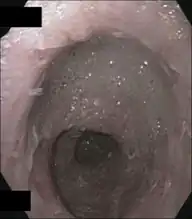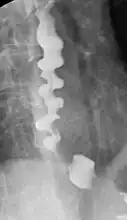Distal esophageal spasm
| Distal esophageal spasm | |
|---|---|
| Other names: Diffuse esophageal spasm | |
 | |
| A barium swallow showing a corkscrew appearance due to distal esophageal spasm | |
| Specialty | Gastroenterology |
| Symptoms | Difficulty swallowing, regurgitation, chest pain[1] |
| Complications | Achalasia[2] |
| Usual onset | Around 60 yr old[2] |
| Causes | Unknown[1] |
| Risk factors | GERD, obesity, high cholesterol, high blood sugar[1] |
| Diagnostic method | Esophageal manometry, barium swallow[1][3] |
| Differential diagnosis | Angina, esophageal cancer, esophageal stricture, esophagitis, achalasia, esophageal web[1] |
| Treatment | Peppermint oil, nitrates, calcium channel blockers, esophageal dilation, botulinum toxin injects[2][1] |
| Frequency | 1 per 100,000 people per year[1] |
Distal esophageal spasm (DES), also known as diffuse esophageal spasm, is a condition in which there is uncoordinated contractions of the esophagus.[1] Symptoms may include difficulty swallowing, regurgitation, felling like something is stuck in the throat, and chest pain.[1][3] Difficulty swallowing may occur with both solids and liquids.[1] Complications may rarely include achalasia.[3][2]
The cause is unknown.[1] Episodes may be triggered by eating quickly or foods at extremes of temperature.[1] Risk factors include GERD, obesity, high cholesterol, and high blood sugar.[1] While the esophageal contractions are uncoordinated they are of normal strength and the lower esophagus opens normally.[1] Diagnosis may be supported by esophageal manometry, with testing such as endoscopy and barium swallow done to rule out other causes.[1] It is a type of esophageal motility disorder.[2]
Treatment options include peppermint oil, nitrates, calcium channel blockers, esophageal dilation, and botulinum toxin injects.[2][1] Proton-pump inhibitors may be used to treat associated GERD.[1] Rarely surgery may be carried out.[1] Outcomes are variable.[1]
Diffuse esophageal spasm affects about 1 per 100,000 people per year.[1] It represents less than 10% of no heart related chest pain.[1] It is most common in those around the age of 60 and women are affected more often than men.[2][1] The condition was first described in 1889 by Osgood.[2]
Signs and symptoms
DES manifests as intermittent difficulty swallowing solid foods and liquids (dysphagia), and atypical chest pain. The chest pain may appear similar to cardiac chest pain (angina pectoris), so investigating the possible existence of heart disease is often indicated.[4]
Causes
The causes of diffuse esophageal spasm is unclear.[1] It is thought, however, that many cases are caused by uncontrolled brain signals running to nerve endings. Therefore, suppression medication is often the first-line therapy such as antidepressants and anti-epileptic medication are prescribed. It has also been reported that very cold or hot beverages can trigger an esophageal spasm. Avoidance therapy benefits some people, but it has not been medically proven. Food allergies or intolerances may also be a cause in which spasms may be triggered within hours or days from the offending foods.
Diagnosis
Several radiographic findings are suggestive of DES, such as a "corkscrew esophagus" or "rosary bead esophagus" appearance on barium swallow x-ray, although these findings are not unique to DES.[4]
 Upper endoscopy shows corkscrew esophagus
Upper endoscopy shows corkscrew esophagus Corkscrew appearance of the esophagus.
Corkscrew appearance of the esophagus.
Treatment
Several medications may be used including nitroglycerin, hyoscine butylbromide, calcium channel blockers, hydralazine, and anti-anxiety medications.[4] Acid suppression therapy, such as proton-pump inhibitors, are often the first-line therapy.
Procedures
Botulinum toxin, which inhibits acetylcholine release from nerve endings, injected above the lower esophageal sphincter may also be used in the treatment of DES. Small studies have suggested benefit from endoscopic balloon dilation in certain patients, but all of the above have a low percentage of success in treating the condition; whilst the treatments work in some sufferers, it does not work for everyone.[5] In extremely rare cases, surgery may be considered.[4]
Epidemiology
It affects about 1 per 100,000 people per year.[1]
See also
References
- 1 2 3 4 5 6 7 8 9 10 11 12 13 14 15 16 17 18 19 20 21 22 23 24 Goel, S; Nookala, V (January 2019). "Diffuse Esophageal Spasm". StatPearls [Internet]. PMID 31082150.
- 1 2 3 4 5 6 7 8 Khalaf, M; Chowdhary, S; Elias, PS; Castell, D (September 2018). "Distal Esophageal Spasm: A Review". The American journal of medicine. 131 (9): 1034–1040. doi:10.1016/j.amjmed.2018.02.031. PMID 29605413.
- 1 2 3 "Diffuse Esophageal Spasm - Gastrointestinal Disorders". Merck Manuals Professional Edition. Archived from the original on 22 March 2022. Retrieved 20 July 2022.
- 1 2 3 4 Harrison's Principles of Internal Medicine. pp. 1905–1906. ISBN 0071802150.
- ↑ Esophageal Spasm~treatment at eMedicine
External links
| Classification | |
|---|---|
| External resources |